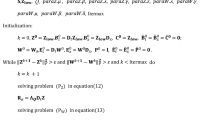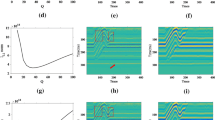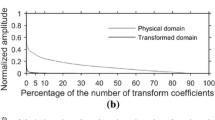Abstract
Seismic signal can be expressed by nonstationary convolution model (NCM) which integrates acoustic impedance (AI), attenuation factor (AF) and source wavelet (SW) into a single formula. Although it provides attractive potential to invert AI, AF and SW, simultaneously, effective joint inversion algorithm has not been developed because of the extreme instability of this nonlinear inverse problem. In this paper, we propose an alternating optimization scheme to achieve this nonlinear joint inversion. Our algorithm repeatedly alternates among three subproblems corresponding to AI, AF and SW recovery until changes in inverted models become smaller than the user-defined tolerances. Also, when we optimize one parameter, other two parameters are fixed. NCM is an explicit linear formula for AI; therefore, AI recovery is accomplished by linear inversion which is regularized by low-frequency model and isotropy total variation domain sparse constraints. However, NCM is a complicated nonlinear formula for AF. To facilitate the AF inversion, we propose a centroid frequency-based attenuation tomography method whose forward operator and observations are acquired from the time-varying wavelet amplitude spectra which is estimated according to Gabor domain factorization of NCM. SW is decoupled from NCM based on Toeplitz structure constraint, and we obtain an orthogonal wavelet transform domain sparse regularized SW inverse subproblem. Split Bregman technique is adopted to optimize AI and SW inverse subproblems. Numerical test and field data application confirm that the proposed nonstationary seismic inversion algorithm can stably generate accurate estimates of AI, AF and SW, simultaneously.
















Similar content being viewed by others
References
Aharon M, Elad M, Bruckstein AM (2006) The K-SVD: An algorithm for designing of evercomplete dictionaries for sparse representation. IEEE Trans Signal Process 54(11):4311–4322
Alaei N, Kahoo AR, Rouhani AK, Soleimani M (2018) Seismic resolution enhancement using scale transform in the time-frequency domain. Geophysics 83(6):V305–V314
Bickel SH, Natarajan RR (1985) Plane-wave Q deconvolution. Geophysics 50(9):1426–1439
Chai X, Wang S, Yuan S, Zhao J, Sun L, Wei X (2014) Sparse reflectivity inversion for nonstationary seismic data. Geophysics 79(3):V93–V105
Chai X, Wang S, Wei J, Li J, Yin H (2016) Reflectivity inversion for attenuated seismic data: physical modeling and field data experiments. Geophysics 81(1):T11–T24
Chen S, Wei Q, Liu L, Li XY (2018) Data-driven attenuation compensation via a shaping regularization scheme. IEEE Geosci Remote Sens Lett 15(11):1667–1671
Chen Z, Wang Y, Chen X, Li J (2013) High-resolution seismic processing by Gabor deconvolution. J Geophys Eng 10(6):1–10
Cheng L, Wang S, Li S, Ji Y (2020) Multi-trace nonstationary sparse inversion with structural constraints. Acta Geophys 68(3):675–685
Craven P, Wahba G (1978) Smoothing noisy data with spline functions: estimating the correct degree of smoothing by the method of generalized cross-validation. NUMER MATH 31(4):377–403
Daubechies I (1992) Orthogonal bases of compactly supported wavelets Ten Lectures on Wavelets, 2nd edn. SIAM, Pennsylvania, pp 161–213
Engelhard L (1996) Determination of seismic-wave attenuation by complex trace analysis. Geophys J Int 125(2):608–622
Foster M (1975) Transmission effects in the continuous one-dimensional seismic model. Geophys J R Astr Soc 42(2):519–527
Futterman WI (1962) Dispersive body waves. J Geophys Res 67(13):5279–5291
Gholami A, Siahkoohi HR (2010) Regularization of linear and non-linear geophysical ill-posed problems with joint sparsity constraints. Geophys J Int 180(2):871–882
Gholami A (2016) A fast automatic multichannel blind seismic inversion for high-resolution impedance recovery. Geophysics 81(5):V357–V364
Goldstein T, Osher S (2009) The split Bregman method for L1-regularized problems. SIAM J Imag Sci 2(2):323–343
Hamid H, Pidlisecky A (2015) Multitrace impedance inversion with lateral constraints. Geophysics 80(6):M101–M111
Hansen PC, O’Leary D (1993) The use of the L-curve in the regularization of discrete ill-posed problems. SIAM J Sci Comput 14(6):1487–1503
Hao Y, Huang H, Gao J, Zhang S (2019) Inversion-based time-domain inverse Q-filtering for seismic resolution enhancement. IEEE Geosci Remote Sens Lett 16(12):1934–1938
Hao Y, Huang H, Luo Y, Gao J, Yuan S (2018) Nonstationary acoustic-impedance inversion algorithm via a novel equivalent Q-value estimation scheme and sparse regularizations. Geophysics 83(6):R681–R698
Hao Y, Wen X, Zhang B, He Z, Zhang R, Zhang J (2016) Q estimation of seismic data using the generalized S-transform. J Appl Geophys 135:122–134
Kim Y, Cho Y, Shin C (2013) Estimated source wavelet-incorporated reverse-time migration with a virtual source imaging condition. Geophys Prospect 61(s1):317–333
Kjartansson E (1979) Constant Q-wave propagation and attenuation. J Geophys Res 84:4737–4748
Kolsky H (1956) The propagation of stress pulses in viscoelastic solids. Phil Mag 1(8):693–710
Li C, Liu X (2015) A new method for interval Q-factor inversion from seismic reflection data. Geophysics 80(6):R361–R373
Lindseth R (1979) Synthetic sonic logs: A process for stratigraphic interpretation. Geophysics 44(1):3–26
Ma M, Wang S, Yuan S, Gao J, Li S (2018) Multichannel block sparse Bayesian learning reflectivity inversion with lp-norm criterion-based Q estimation. J Appl Geophys 159:434–445
Ma X (2001) A constrained global inversion method using an overparameterized scheme: application to poststack seismic data. Geophysics 66(2):613–626
Ma X, Li G, Li H, Li J, Fan X (2020) Stable absorption compensation with lateral constraint. Acta Geophys. https://doi.org/10.1007/s11600-020-00453-w
Margrave GF, Lamoureux MP, Henley DC (2011) Gabor deconvolution: estimating reflectivity by nonstationary deconvolution of seismic data. Geophysics 76(3):W15–W30
Quan Y, Harris JM (1997) Seismic attenuation tomography using the frequency shift method. Geophysics 62(3):895–905
Stark PB, Parker RL (1995) Bounded-variable least-squares: an algorithm and applications. Comput Stat 10:129–141
Van der Baan M (2008) Time-varying wavelet estimation and deconvolution by kurtosis maximization. Geophysics 73(2):V11–V18
Velis DR (2008) Stochastic sparse-spike deconvolution. Geophysics 73(1):R1–R9
Walker C, Ulrych TJ (1983) Autoregressive recovery of the acoustic impedance. Geophysics 48(10):1338–1350
Wang S, Li XY, Qian Z, Di B, Wei J (2007) Physical modelling studies of 3-D P-wave seismic for fracture detection. Geophys J Int 168(2):745–756
Wang Y (2002) A stable and efficient approach of inverse Q filtering. Geophysics 67(2):657–663
Wang Y (2006) Inverse Q-filter for seismic resolution enhancement. Geophysics 71(3):V51–V60
Wang Y (2015) Generalized seismic wavelets. Geophys J Int 203(2):1172–1178
Wang Y (2017) Seismic wavelet estimation Seismic inversion: theory and applications, 1st edn. Blackwell, London, pp 99–103
Wang Y, Ma X, Zhou H, Chen Y (2018) L1–2 minimization for exact and stable seismic attenuation compensation. Geophys J Int 213(3):1629–1646
Wuenschel PC (1965) Dispersive body waves: an experimental study. Geophysics 30(4):539–551
Yu Y, Wang S, Yuan S, Qi P (2011) Phase estimation in bispectral domain based on conformal mapping and applications in seismic wavelet estimation. Appl Geophys 8(1):36–47
Yuan S, Wang S, Luo Y, Wei W, Wang G (2019) Impedance inversion by using the low-frequency full-waveform inversion result as an a priori model. Geophysics 84(2):R149–R164
Yuan S, Wang S, Ma M, Ji Y, Deng L (2017) Sparse Bayesian learning-based time-variant deconvolution. IEEE Trans Geosci Remote 55(11):6182–6194
Yuan S, Wang S, Tian N, Wang Z (2016) Stable inversion-based multitrace deabsorption method for spatial continuity preservation and weak signal compensation. Geophysics 81(3):V199–V212
Zhang G, Wang X, He Z (2015) A stable and self-adaptive approach for inverse Q-filter. J Appl Geophys 116:236–246
Zhang R, Castagna J (2011) Seismic sparse-layer reflectivity inversion using basis pursuit decomposition. Geophysics 76(6):R147–R158
Zhang R, Sen MK, Srinivasan S (2013) A prestack basis pursuit seismic inversion. Geophysics 78(1):R1–R11
Zhou H, Tian Y, Ye Y (2014) Dynamic deconvolution of seismic data based on generalized S-transform. J Appl Geophys 108:1–11
Zhou H, Wang C, Marfurt K, Jiang Y, Bi J (2016) Enhancing the resolution of non-stationary seismic data using improved time–frequency spectral modeling. Geophys J Int 205(1):203–219
Acknowledgements
This work was jointly supported by the Open Fund of State Key Laboratory of Oil and Gas Reservoir Geology and Exploitation (Chengdu University of Technology, No. PLC2020026), the National Natural Science Foundation of China (No. 42004114), Natural Science Foundation of Jiangxi Province (No. 20202BAB211010) and Public Welfare Geological Project Of Anhui Province (No. 2018-g-1-4).
Author information
Authors and Affiliations
Corresponding author
Additional information
Communicated by Michal Malinowski (CO-EDITOR-IN-CHIEF)\Sanyi Yuan (ASSOCIATE EDITOR).
Appendices
Appendix 1
Reformulation of NCM Based on Toeplitz structure constraint
Since W is a Toeplitz matrix, it can be written as
Therefore, \({\mathbf{w}} = \left[ {w_{ - J} ,w_{ - J + 1} , \ldots ,w_{0} , \ldots w_{J} } \right]^{T}\) can represent the time domain SW. Then, we rewrite W as
where \({\mathbf{I}}_{n}\) is a shift matrix whose elements are zero except that the \(n^{th}\) sub-diagonal is one, for example \({\mathbf{I}}_{0} = \left[ {\begin{array}{*{20}c} 1 & {} & {} \\ {} & \ddots & {} \\ {} & {} & 1 \\ \end{array} } \right],\begin{array}{*{20}c} {} \\ \end{array} {\mathbf{I}}_{ - 1} = \left[ {\begin{array}{*{20}c} 0 & 1 & {} & {} \\ {} & \ddots & \ddots & {} \\ {} & {} & \ddots & 1 \\ {} & {} & {} & 0 \\ \end{array} } \right],\begin{array}{*{20}c} {} \\ \end{array} {\mathbf{I}}_{1} = \left[ {\begin{array}{*{20}c} 0 & {} & {} & {} \\ 1 & \ddots & {} & {} \\ {} & \ddots & \ddots & {} \\ {} & {} & 1 & 0 \\ \end{array} } \right]\). Substituting Eq. (36) into Eq. (27), we can obtain the following formula deduction process:
where \({\mathbf{B}}_{n} = {\mathbf{I}}_{n} {\overline{\mathbf{R}}}\); \({\mathbf{A}}_{3}\) is a reformulated matrix which is expressed by
Appendix 2
Split Bregman method for solving hybrid sparse constraint problem
Here, we rewrite Eq. (33):
Then, we define \(|({\mathbf{d}}_{x} ,{\mathbf{d}}_{y} )|_{1} = \left| {\sqrt {({\mathbf{D}}_{x} {\mathbf{m}})^{2} + ({\mathbf{D}}_{y} {\mathbf{m}})^{2} } } \right|_{1}\), \({\mathbf{d}}_{x} = {\mathbf{D}}_{x} {\mathbf{z}}\), \({\mathbf{d}}_{y} = {\mathbf{D}}_{y} {\mathbf{z}}\) and \({\mathbf{d}}_{c} = {\mathbf{Cz}}\). Therefore, Eq. (39) can be iteratively solved by (Goldstein and Osher 2009)
where “ik” denotes the iteration number; \(\eta\) and \(\nu\) are regularization parameters. Also, decoupling the l1 and l2 norm in Eq. (40), we will yield
Now, we have split the l1 and l2 penalty terms and yielded three simple subproblems. Equation (B3a) can be solved via the following linear equation with inequality constraint:
where \({\mathbf{C}}^{T} {\mathbf{C}} = {\mathbf{I}}\) is an identity matrix; \({\mathbf{U}}^{ik} = {\mathbf{A}}^{T} {\mathbf{y}} - \eta {\mathbf{C}}^{T} ({\mathbf{b}}_{c}^{ik} - {\mathbf{d}}_{c}^{ik} ) - \nu {\mathbf{D}}_{x}^{T} ({\mathbf{b}}_{x}^{ik} - {\mathbf{d}}_{x}^{ik} ) - \nu {\mathbf{D}}_{y}^{T} ({\mathbf{b}}_{y}^{ik} - {\mathbf{d}}_{y}^{ik} )\). The bound constrained problem in Eq. (42) is solved by bounded variable least-squares (BVLS) algorithm (Stark and Parker 1995). Both Eq. (41b) and (41c) are standard l1 norm based denoising problems whose solutions can be explicitly expressed by shrinkage formulas (Goldstein and Osher 2009):
where symbol “\(\circ\)” denotes Hadamard product between two vectors, \({{\varvec{\uprho}}}_{1} = {\mathbf{Cz}}^{it + 1} + {\mathbf{b}}_{c}^{it}\) and \({{\varvec{\uprho}}}_{2} = \sqrt {({\mathbf{D}}_{x} {\mathbf{z}}^{it + 1} + {\mathbf{b}}_{x}^{it} )^{2} + ({\mathbf{D}}_{y} {\mathbf{z}}^{it + 1} + {\mathbf{b}}_{y}^{it} )^{2} }\).
Rights and permissions
About this article
Cite this article
Hao, Y., Wen, X., Zhang, H. et al. Nonstationary seismic inversion: joint estimation for acoustic impedance, attenuation factor and source wavelet. Acta Geophys. 69, 459–481 (2021). https://doi.org/10.1007/s11600-021-00555-z
Received:
Accepted:
Published:
Issue Date:
DOI: https://doi.org/10.1007/s11600-021-00555-z




